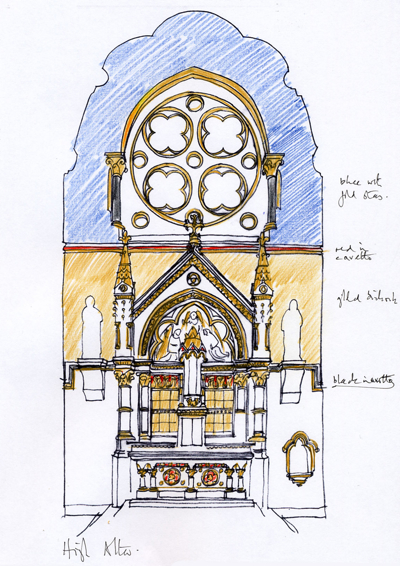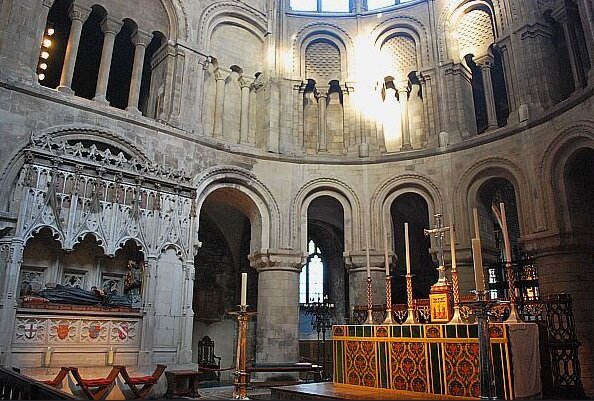Our Regular Venues
With a history as jam-packed with fires, wars and further misadventure as London's, it is a wonder that our capital has any historic buildings left! But this is a city with some of the most beautiful and awe-inspiring architecture in the world — and you get to listen to concerts inside!
Take a stroll below to see some of the amazing places Brandenburg presents concerts — and then come along and join us.
Corpus Christi
1-5 Maiden Lane, London WC2E 7NB
www.corpuschristimaidenlane.org.uk
A hidden gem of Covent Garden in London, Corpus Christi is the Westminster Diocesan Shrine of the Blessed Sacrament, and was elevated to this dignity by Cardinal Nichols in 2018. Built in 1874 as an act of reparation for sins against the Blessed Sacrament during the Reformation, the church holds a very special place in the hearts of Catholics around the world. The hymns Sweet Sacrament Divine and O Sacred Heart were composed here by a former Parish Priest, Fr. Francis Stanfield. Corpus Christi has also become known as the Catholic Actors’ Church.
London Charring Cross
(5 mins)
Covent Garden
(4 mins)
Holy Trinity Prince Consort Road
Prince Consort Road, London SW7 2BA
http://www.htsk.co.uk/
Built in a 14th century style but dating from 1901, the interior of Holy Trinity is a showpiece of the very best ecclesiastical fixtures and fittings of the Edwardian era. All the major decoration in the church including the reredos, the altar, the choir stalls, the stained glass, the pulpit and the font were designed by famous Victorian architect G.F.Bodley and were completed by his partner Cecil Hare after Bodley’s death.
Situated in the heart of ‘Albertopolis’ it is surrounded by the museums, exhibition halls and educational institutes that are the legacy of the 1851 Great Exhibition, championed by Queen Victoria’s Prince Consort, Prince Albert.
South Kensington
Gloucester Road
(12 mins)
(12 mins)
Holy Sepulchre
Holborn Viaduct EC1A 2DQ
https://hsl.church/
There has been a worshipping community at Holy Sepulchre since at least 1137 when a charter records that Rahere (the founder of St. Bartholomew’s Hospital) appointed ‘Hagno the Clerk’ as priest of Holy Sepulchre.
Situated near to the Old Bailey and Newgate Prison, St Sepulchre's shares some pretty gruesome history. The Execution Bell – a hand bell on display in the church – was rung by the St Sepulchre's bellman at midnight of an execution day.
More happily, in the Twentieth Century St Sepulchre's has become known as the National Musicians' Church. A young Henry Wood learned to play the organ there, and was appointed Assistant Organist aged 14. In 1944 his ashes were laid to rest in what is now called The Musicians' Chapel.
Photo by DAVID ILIFF. License: CC BY-SA 3.0
City Thameslink
(1 min)
St Paul’s
(3 mins)
St Bartholomew the Great
Cloth Fair, London EC1A 7JQ
www.greatstbarts.com
The Priory Church of St Bartholomew the Great is London’s oldest parish church, founded in AD 1123 as part of a monastery of Augustinian Canons. The Priory was dissolved in 1539 and the nave of the Church was demolished. The monastic buildings were largely intact and the Canons' choir and sanctuary were preserved for parish use. Under Queen Mary, there was briefly a house of Dominican friars here, before it reverted to being a Parish Church under Queen Elizabeth I. Various parts of the building were damaged or destroyed through the centuries until the restoration began in the 19th century, first in the 1860s and then, under Sir Aston Webb, in the 1880s and 90s and on into the 20th century.
Farringdon
(7 mins)
Barbican
(4 mins)
St Gabriel's Pimlico
Warwick Square SW1V 2AD
www.stgabrielspimlico.com
In a rapidly growing corner of 1850s London the Marquis of Westminster, who then owned all the land, granted the freehold of a plot at the South-West end of Warwick Square and £5,000 for the building of a church. The building was designed by Thomas Cundy Junior, Surveyor of the Grosvenor Estates, and consecrated in May 1853. Over the years various improvements and extensions followed, including the addition of the Lady Chapel at the south of the chapel, and insertion of the beautiful East window designed by C E Kempe, one of the great Victorian stained-glass window designers. During the Second World War a single bomb blew out most of the windows, but spared the East window – which now forms a magnificent centrepiece in this light, airy cathedral-like venue.
London Victoria
(9-10 mins)
Pimlico
(9-10 mins)
St James’s Sussex Gardens
Sussex Gardens, Paddington W2 3UD
www.stjamespaddington.org.uk
St James’s Sussex Gardens is the Parish Church of Paddington. The site dates back to before 1222 as a chapel, followed by the church of St Katherine and later St James’s. The 1843 church was deemed too small by the early 1880s and G E Street – architect of the Law Courts in the Strand – was engaged to redesign the church, which was reconsecrated in December 1882.
In May 1884, Constance Mary Lloyd married Oscar Fingal O'Flahertie Wills Wilde in St James’s.
Please note St James’s Sussex Gardens is not accessible step-free.
London Paddington
(6 mins)
Lancaster Gate
(4 mins)
St John's Waterloo
Waterloo Road, London SE1 8TY
www.stjohnswaterloo.org
The Church of St John was built to the designs of the architect Francis Octavius Bedford in 1824 in a Greek style inspired by Bedford’s background as a well-respected Greek scholar. Bedford’s churches were fiercely criticised by contemporary critics at a time when the tide was turning away from the Greek revival towards Gothic. St John’s however gained more critical appreciation mainly because of its fine spire which used classical detail to build up a more traditional English parish church shape.
The Church was struck by a bomb in 1940, when the roof and much of the interior was destroyed. The building stood open for ten years until it was restored in 1950. In 1951 the Church was rededicated as the Festival of Britain Church.
London Waterloo
(2 mins)
Waterloo
(2 mins)
Thumbnail photo © John Salmon (cc-by-sa/2.0)
St Stephen’s Gloucester Road
Gloucester Road and Southwell Gardens, London SW7 4RL
www.saint-stephen.org.uk
St Stephen’s Church is a Grade II* listed Anglican church in South Kensington’s tourist and museum district, and for nearly 150 years it has served the needs of the local community and visitors from all over the world. The church was built in 1867, and is one of the best remaining churches by the 'rogue' Victorian architect, Joseph Peacock. St Stephen’s was the parish of poet TS Eliot, and he served as Church Warden from 1934 to 1959.
Gloucester Road
(3 mins)
St Stephen Walbrook
39 Walbrook, London EC4N 8BN
www.ststephenwalbrook.net
In the second century A.D. a temple of Mithras stood on the bank of the Walbrook, a stream running across London from the City Wall near Moorfields to the Thames. In this temple Roman soldiers sought valour and virility in shower-baths of hot blood from slaughtered bulls. After the recall of the legions to Rome in 410 A.D. the building became a quarry; the locals left only the foundations. These were discovered when Bucklersbury House was built in 1953-1957, and they are preserved to this day. However, there were no foundations of the Christian church which stood on the site and was a going concern in 1090 A.D. when it was given to the monastery of St. John by Eudo, Dapifer (cupbearer) to Henry I. It was Saxon, not Norman, and must have been built on the Mithraic foundations to hallow a heathen site. By 1428 this church and its graveyard were too small for the parish, and licences were obtained to build a larger church on higher ground some twenty meters to the east, the ground having risen about six meters; and Walbrook, no longer a stream, was now a street.
Photo by DAVID ILIFF. License: CC BY-SA 3.0
London Cannon Street
(2 mins)
Bank
(2 mins)
Cadogan Hall
5 Sloane Terrace, Belgravia, London SW1X 9DQ
https://cadoganhall.com/
Set in a fantastic location in the heart of Chelsea Cadogan Hall has become one of London’s leading venues. The Hall’s 950 seats, excellent acoustic and luxurious surroundings makes it the first choice for some of the UK’s top orchestras, as well as a favourite London destination for international touring orchestras. Cadogan Hall is the chosen venue for the world-famous BBC Proms Chamber Music Series and also offers a vibrant selection of contemporary, jazz, folk and world music events as well as talks, debates and conferences.
London Victoria
(8-10 mins)
Sloane Square
(3 mins)











































